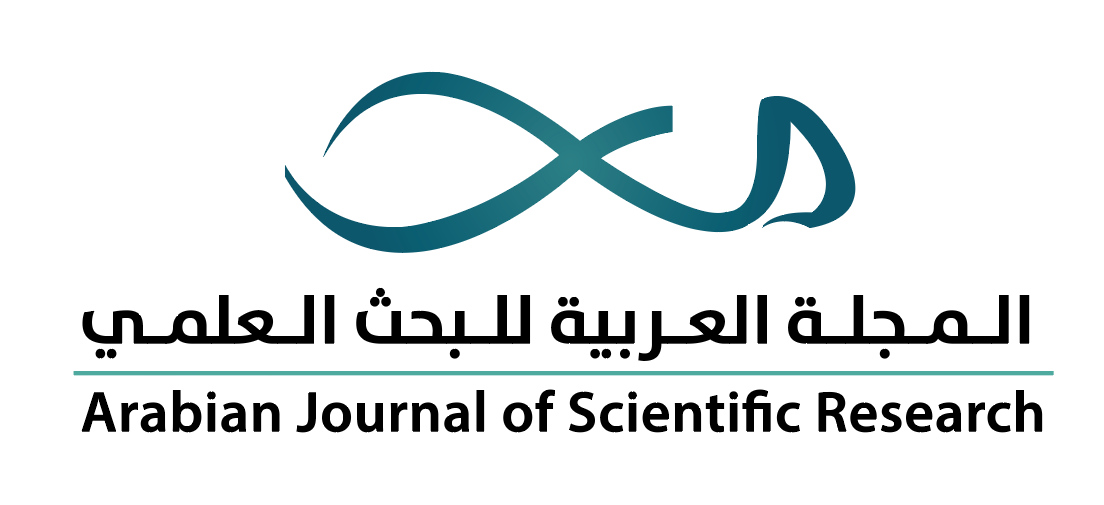-
oa التوصيف الفيزيائي-الكيميائي للدولوميت الطّبيعي لإزالة الرّصاص والكادميوم بكفاءة من المحاليل المائية
- Source: Arabian Journal of Scientific Research-المجلة العربية للبحث العلمي, Volume 5(2024), Issue 1, Apr 2024,
-
- 20 September 2023
- 30 November 2023
- 30 April 2024
- Previous Article
- Table of Contents
- Next Article
Abstract
الملخص
طُبِّقت طرق التّوصيف الفيزيائي-الكيميائي للمواد الطّبيعية الغنيّة بالكلسيات لتحديد كفاءتها في إزالة أيونات الرّصاص والكادميوم من محاليلها المائيّة. وجُمعت عيّنات معدن الدّولوميت الطّبيعي من موقع جبل رهاش جنوب تونس وطُحنت لاستخدامها في إزالة أيونات الرّصاص والكادميوم من محاليلهما المائيّة. وأُجريت تجارب الإزالة على دفعات عن طريق خلط مسحوق الدّولوميت بنسب محدّدة مع محلول معدني يحتوي على أيونات الرّصاص والكادميوم، ثم وُضع الخليط على هزّاز كهربائي لمدّة 60 دقيقة، بسرعة اهتزاز 200 دورة/دقيقة، عند درجة حرارة الغرفة (25 درجة مئويّة)، وقيمة الأس هيدروجيني 6. كان تركيز الدّولوميت 3 غرامات/لتر بينما الكادميوم والرّصاص 10 و100 ملي غرام/لتر على التّوالي. وأظهرت النّتائج أنّ عيّنات الدّولوميت محلّ الدّراسة تتكوّن من أكاسيد الكالسيوم والمغنيسيوم وبعض من الشّوائب الأخرى. وكشفت بيانات الامتزاز أن عيّنات الدّولوميت المُجمّعة من متكوّن رهاش الترياسي (جنوب تونس) أزالت كميات كبيرة من أيونات الرّصاص والكادميوم من محاليلهما. إذ حقّقت كفاءة إزالة 24.80 - 33.25 ملي غرام رصاص/غرام دولوميت و1.31- 1.77 ملي غرام كادميوم/غرام دولوميت. كما أوضحت البيانات أيضاً أن أكثر من 95% من السّعة الامتزازيّة الكليّة تحقّقت في 30 دقيقة من التقليب، ولكن استمرّ التّقليب لمدّة 60 دقيقة للوصول لحالة الاتّزان. وأشارت هذه النّتائج إلى أن دولوميت متكوّن جبل رهاش الترياسي، بجنوب تونس، يمكن استخدامها بفاعليّة لإزالة أيونات الرّصاص والكادميوم من المحاليل المائيّة.
Physico-chemical characterization of naturally abundant carbonates has been undertaken to evaluate their potentialities in the removal of lead and cadmium ions in aqueous systems. Powdered dolomite samples, collected from the Jebel Rehach location, southern Tunisia, were used in their natural form for the removal of both cadmium and lead in aqueous conditions. The removal experiments were carried out in batch by mixing known amount of dolomite powder with a metal solution (lead or cadmium). The mixture was shaken at 200 rpm under the experimental conditions of pH 6, temperature (25°C), dolomite concentration 3g/L, and cadmium (10 mg/L) and lead (100mg/L) solutions. Shaking time was 60 min. Our results showed that the studied dolomite samples were mainly composed of calcium and magnesium oxides; other impurities were also detected. Adsorption data showed that dolomitic samples of the Triassic Rehach formation (southern Tunisia) removed substantial amounts of lead and cadmium ions in aqueous systems. It was found that lead removal efficiency reached 24.80 and 33.25 mg/g, which is much higher than that of cadmium (1.31 to 1.77 mg/g). It was also observed that more than 95% of the total adsorptive capacity was achieved after 30 min of agitation, but 60 min was used to ensure equilibration time. These results suggested that the Triassic Rehach dolomite, Tunisia, can be effectively used for capturing lead and cadmium ions in aqueous conditions.



